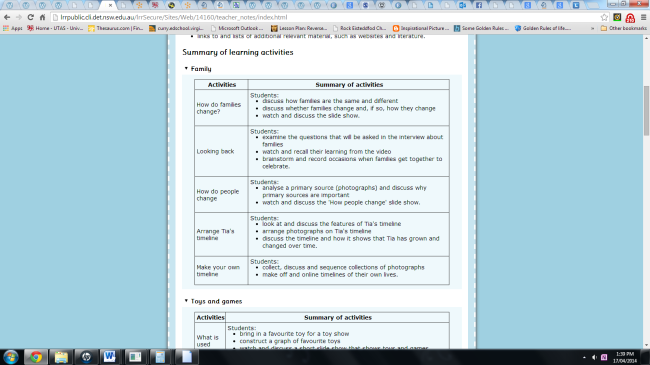Information and communication technology [ICT] has become a major yet expensive feature of contemporary education. Schools purchase computer programs to enhance students’ learning (Gilbert & Hoepper, 2014). However not all computer programs are appropriate for all year levels. The Melbourne Declaration on Educational Goals for Young Australians, Goal two successful learners outlines the need for students to become productive and creative users of ICT. Information and communication technology is now one of the General Capabilities of the Australian Curriculum.
How Times Change is a free teacher resource developed by Scootle (www.scootle.edu.au). that has been endorsed by The Learning Federation [TLF]. The resource How Times Change aligns with the Australian Curriculum Year 1 focus Present and Past Family Life. Students in Year one begin to explore the changes and links that occur over time by undertaking the study of present and family life within the context of their own lives. Students explore differences and similarities of family life by comparing the past with the present (ACARA).
The resource is a flexible model that can be divided into five sections including family, toys and games, getting around, at home and at school. Students should complete the family section first before progressing to other sections. Within each section there are many learning activities that students can participate and become engaged with. The screenshot provided is one of the five learning sections.
The Summary of learning (www.scootle.edu.au).
The website allows teachers to establish and tailor individualised learning paths for their students. For example teachers have the capability to restrict or extend students learning activities as well as providing annotations (Taylor, Fahey, Kriewaldt & Boon, 2012).
Students will find this resource easy to navigate. Both text and audio instructions are incorporated into each section of this resource. This will insure all students are included and able to participate in the activities including students who have lower literacy abilities.
The key learning objectives of this resource all relate to the achievement standards of the Australian Curriculum for Year One students and are as follows
* Students sequence timelines using photographs. After students have mastered this activity they are able to create their own timelines.
* Students develop the ability to discuss and describe objects from the present and the past
* Students gain the ability to classify objects from the present and the past.
*Students develop and use time-related language.
* Students develop understanding of the differences of themselves, their classmates and people in the past.
There are many benefits of integrating ICT into the humanities and social science curriculum. Students’ historical knowledge is extended by participating in the computer programs. In addition to this learning students are developing their computer literacy skills. Computer programs allow students to learn and understand the past like the people who lived in the past through historical websites such as Trove. Technologies such as multimedia and virtual reality enable students to communicate their new gained knowledge in the present (Cress, Dimitrove & Speecht, 2009).
